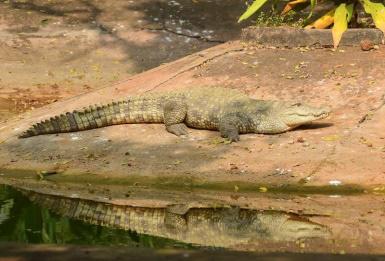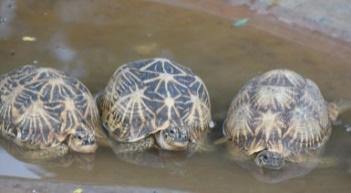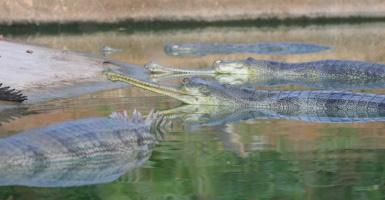
8 minute read
CHAPTER 3. ANIMAL BEHAVIOR
To understand animals and their habitat chosen some of this animals species from the existing zoo to understand their habitat. And animals is chosen such a way that can understand different categories of habitat.
Mammals:
Advertisement
3.1 Bengal Tiger (Panthera tigirs) 3.2 Leopard (Panthera) (Panthera pardus) 3.3 Jackal (Canis aureus) 3.4 Wild Dog (Lycaon pictus) 3.5 Hippopotamus (Hippopatamus amphibius) 3.6 Deer Barking (Kakar) (Muntiacus muntijak) 3.7 Macaque Rhesus (Macaca mulata) 3.8 Common Marmoset (Callithrix jacchus) 3.9 Macaque Bonnet (Macaca radiata)
Reptiles:
3.10 Crocodile Marsh (Mugger) (Crocodylus palustris) 3.11 Crocodile Long Snouted (Gharial) (Gavialis gangeticus) 3.12 Tortoise Indian Star (Geochelone elegans)
3.1 Bengal Tiger (Panthera tigirs)
The Bengal tiger is a population of the Mainland Asian tiger in the Indian subcontinent. It was treated as the nominate tiger subspecies prior to 2017. Range: The Bengal tiger is found primarily in India with smaller populations in Bangladesh, Nepal, Bhutan, China and Myanmar. It is the most numerous of all tiger subspecies with more than 2,500 left in the wild. Habitat: The habitat is varied: grasslands, subtropical and tropical rainforests, scrub forests, wet and dry deciduous forests and mangroves. Diet: The tiger is a carnivore. It prefers hunting large ungulates such as chital, sambar, gaur, and to a lesser extent also barasingha, water buffalo, nilgai, serow and takin. Among the medium-sized prey species it frequently kills wild boar, and occasionally hog deer, muntjac and grey langur. Weight : Male:220 kgs; Female: 140 kgs. Longevity: A Bengal tiger has an average lifespan of 8 to 10 years in the wild. Breeding Season: November to April.
Fig 3.1 Image of bengal tiger
3.2 Leopard (Panthera pardus)
The Panther / Leopard is very agile and stealthy predator. It can run at 60 kms per hour, leap over 6mters and jump up to 3 mtrs. Range: It is found in sub-Saharan Africa with fragmented populations in Pakistan, India, Indochina, Malaysia and China. Habitat: It prefers mainly grasslands, woodlands, river side forests and rain forest terrians. Diet: Mainly consists of ungulates, monkeys, rodents, reptiles, amphibians, birds and fishes are also hunted and eaten. Weight : Male:37-91 kgs; Female: 28-60 kgs. Longevity: 20 years. Gestation : 90-105 days. Offspring: Two or Four. Fig 3.2 Image of leopard Breeding Season: Throughout the year.
3.3 Jackal (Canis aureus)
Jackals are medium-sized omnivorous mammals of the genus Canis, which also includes wolves, coyotes and the domestic dog. Range: In India, they are found throughout the country upto 3000 m, and also in South-eastern Europe and South Asia up to Myanmar. Habitat: Majority of them live near towns, agricultural fields, dense grasses and scrub lands etc. Diet: They are opportunistic feeder and prey such as rabbits, rodents, birds, insects, fishes, monkeys, fawns of deer and antelope. Weight : 7 - 15 kgs. Longevity: 16 years. Gestation : 2 months. Offspring: Two to four. Breeding season: December to January. Fig 3.3 Image of jackal
3.4 Wild Dog (Lycaon pictus)
The Dhole is a medium sized carnivore with reddish brown colour body coat and bushy black tail. Size: 43 to 55 cms at the shoulder, head and body about 90 cms in length, tail 40 to 42 cms. Habitat: Found in central and eastern Asia. Hunts in Packs of 10 to 30 individuals to bring down. Diet: They prey like Spotted dear, Sambar etc. Weight : Male : 16-21 Kgs; Female: 9-16 Kgs. Longevity: 10-12 years. Gestation : 2 months. Offspring: Four to Six pups born in January or February. Breeding Season : November & December. Fig 3.4 Image of wild dog
3.5 Hippopotamus (Hippopatamus amphibius)
The common hippopotamus, or hippo, is a large, mostly herbivorous, semiaquatic mammal native to sub-Saharan Africa, and one of only two extant species in the family Hippopotamidae, the other being the pygmy hippopotamus. Habitat: Hippos live in sub-Saharan Africa. They can only survive in areas with abundant water, though, so they live in areas with rivers and lakes. Hippos are amphibious animals and spend up to 16 hours per day in the water, according to National Geographic. Diet: Like almost any herbivore, they consume other plants if presented with them, but their diet in nature consists almost entirely of grass, with only minimal consumption of aquatic plants. Weight : Male: 1500-1800 kgs; Female: 1300 – 1500 kgs Longevity: 40 - 50 years. Gestation : 243 days. Offspring: One single baby hippopotamus, or calf Breeding Season : Between October and April.
Fig 3.5 Image of hippopotamus
3.6 Barking Deer (Muntiacus muntijak)
It lives as solitary or in pairs, male slightly larger in body weight than female. Height is 50 cm to 85 cm. Range: They found in Southern & South Easter Asia. It is found throughout the country. Habitat: Lives in thick forests but comes out in the open as well as forest edges for grazing. Diet: They are nibblers feed on grasses, buds of flower, green leaves and fruits. Weight : 14 – 28 kgs. Longevity: 18 – 25 years. Gestation : 160 – 180 days. Offspring: Usually one but rarely two. Breeding Season : February.
Fig 3.6 Image of barking deer
3.7 Rhesus Macaque (Macaca mulata)
The orange – redfur on its rump distinguishes, it from any other Indian Monkey. It lives in troops of 8 to 180. Rhesus (RH) factor in blood was first discovered in this animal and this was first primate to sent into the space. Range: Northern India, Bangladesh, Burma, Thailand, Pakistan, Afghanistan, Southern China and neighboring areas. Habitat: Inhabit all forest types, open plains, near villages and towns. Diet: It is omnivorous, feeds on fruits, seeds, roots herbs, insects, ants and beetles. Longevity: 15 – 20 years Gestation : 135 to 194 days. Offspring : Usually one is born. Breeding season : March to June and September to October. Weight : Male: 7 – 10 kg; Female: 5-6
3.8 Common Marmoset (Callithrix jacchus)
Common marmosets are small-bodied New World monkeys that are amottled brown, grey and yellow colour with white ear tufts and long banded tails. Range: They are endemic to Brazil, seen in the North-eastern Central forests from the Atlantic coast at Rio-Grande. Habitat: Atlantic coastal, dry, seasonal, semidecidous island, riverine forests in dry thorny scrub and savnna forests. Diet: Sweet fruits, nectar, flowers, spiders, lizards, snails, grass hoppers, crickets, cockroaches and cicadas. Size: Male : 18 – 20cm ; Female:16-18 cm. Weight : Male: 250-260 gms; Female:230-235 gms. Gestation : 140 to 148 days Longevity: 15 – 16 years (in captivity) Breeding : Every six months. Breeding Age : 2 to 16 years Litter size : Two babies per year.
3.9 Macaque Bonnet (Macaca radiata)
Habitat: They often wander onto dry prairies, although it is not their preferred habitat. Bonnet macaques coexist with several primate species. Bonnet macaques live as commensals with humans and are most abundant on the outskirts of human settlements. In those areas they rely on trash and food generated by villagers and visitors. Behavior: Bonnet macaques are arboreal and terrestrial quadrupeds, although they spend much of their time on the ground. They are typically active during the day. Bonnet macaques use lateral-sequence footfall patterns which allows three or more limbs to remain in contact with a branch and reduces lateral swaying. Juvenile bonnet macaques use their 50 to 70 cm prehensile tail as an anchor when going down steeply inclined branches or for grasping support. Food Habits: Primary Diet: omnivore Animal Foods: reptiles eggs insects Plant Foods: leaves wood, bark, or stems seeds, grains, and nuts fruit nectar flowers
3.10 Marsh Crocodile (Muggar) (Crocodylus palustris)
They are 23 species of crocodilians distributed in the world. They can go without food for long periods, even for months. Range: They are found throughout India, Bangladesh, Nepal, Sri Lanka and Pakistan. Habitat: These are found in Lakes, rivers, marshes and large water bodies. Diet: Feeds on fish, other reptiles and mammals. Body length: Adults 4 to 5 meters. Life span : 70 years. Nesting Season: February to April. Clutch size : 8 to 45 eggs. Weight : 100 to 200 kgs. Incubation period : 55 to 75 days. Breeding life : 50 years.
3.11 Crocodile Long Snouted (Gharial) (Gavialis gangeticus)
There is only species of gharial in the world. It is the second-longest of all living crocodilians, after the salt water crocodile. Range: They are found in the river systems of the Indus, Brahmaputra, Gangas, Mahanadi etc. Habitat: It is a riverine species and prefers the calmer areas in the perennial deep fast moving rivers. Diet: Adults feed on fish and young ones eat insects larvae, small frogs. Body length: 5 to 7 meters. Life span : 100 years. Nesting Season: March to April. Clutch size : 10 to 97 eggs. Snout : Long, beak like, sharply demarcated from head. Incubation period : 75 to 80 days. Breeding life : 50 years.

Fig 3.7 Image of marsh crocodile

Fig 3.7 Image of marsh crocodile
3.12 Indian Star Tortoise (Geochelone elegans)
They are around 242 species of turtiles, of 35 are found in India. These are longest living reptiles, and live more than 100 years. Range: They are found in the Indian subcontinent and Sri Lanka. Habitat: Young one are more aqudie from adults which are semi terrestrial. Diet: Feeds on grasses, fallen fruit, flowers and leaves of succulent plants. Body length: Male : about 20cm. Female : about 30cm. Life span : 30 to 35 years. Clutch size : 2 to 6 clutches every year with 2 to 7 eggs per clutch.
Fig 3.9 Image of indian star tortoise




